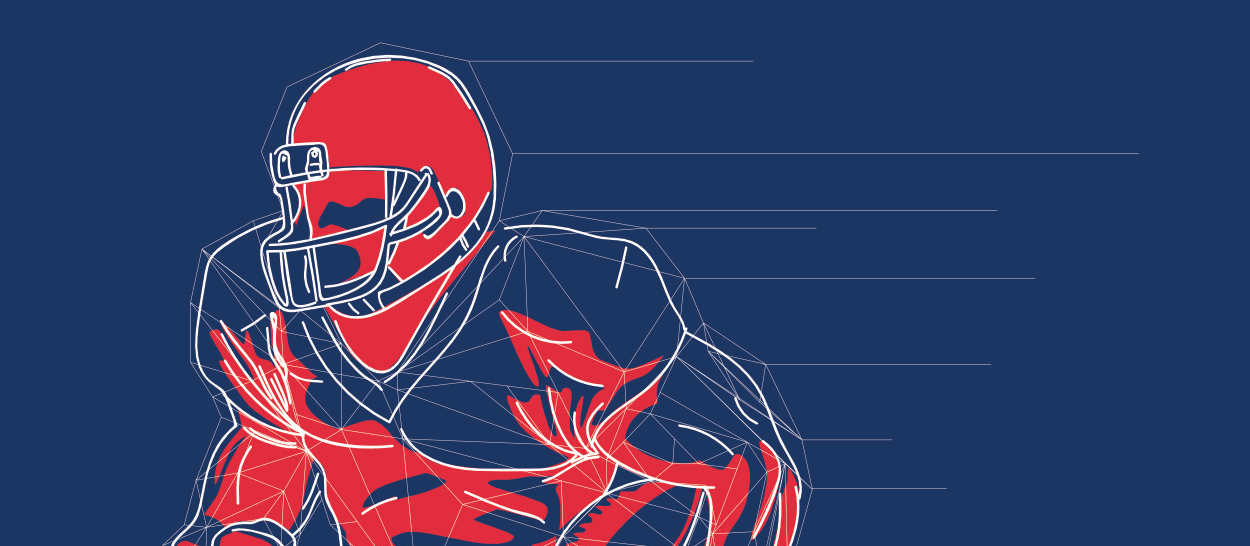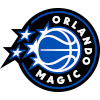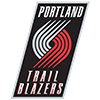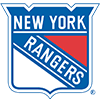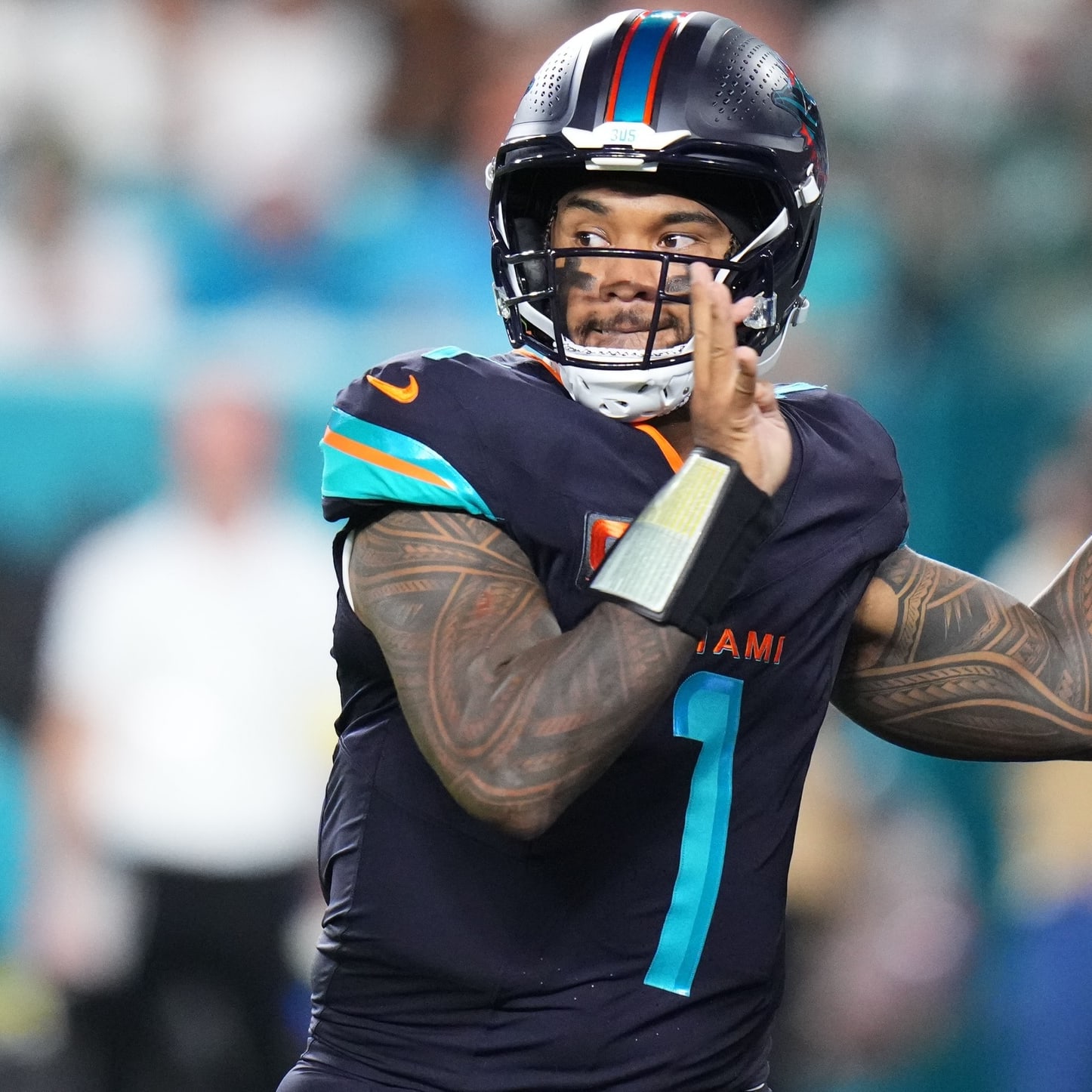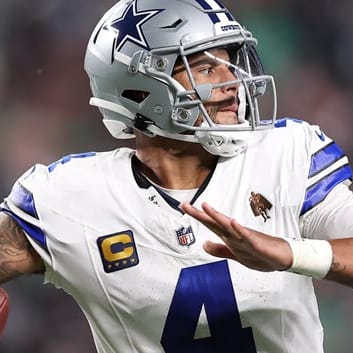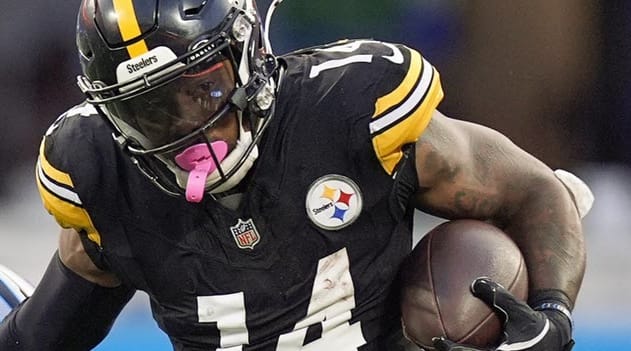Probably like most, I play daily fantasy sports for the fun and the challenge, hoping to do well enough to grind out a solid profit over the course of a season. Sure, I'll play in some of the bigger guaranteed prize pool (GPP) tournaments, but the idea of winning a top prize was a pipe dream and never something I expected, or even had as a goal – I'm not a big multi-entry player, usually only playing my best two lineups at $25 and then maybe a few more at lower levels depending on the weekend.
Well, apparently the casual player can win big. In Week 6 last season, with only two entries, I finished second out of more than 75,000 teams in the FanDuel $25 entry Sunday Million contest, netting a six-figure payday.
This is the story of that day.
It was, simply put, incredible, made even more special as it came a day after my wife's 40th birthday. But a cakewalk to the winner's circle it was not. Injuries and a bust at wide receiver, among other things, threatened to derail my team.
I'll detail how, with sound strategy and a little luck, it all played out, and describe the process I use to pick DFS lineups. Hopefully, it helps you pick a big winner this season.
Before we get started, I must add I am a bit different from most DFS players in that I never track my results during games. I love football Sundays, and after I set my lineups I prefer to relax and watch games with my wife or friends and not worry about DFS standings. I know which players I am rooting for, of course, but it takes away from my fun of watching if I refresh the standings every 10 minutes. Apparently this is weird, or so I'm told, but it is personal preference and becomes even more pronounced when I am doing well, as it did on this day.
The Saints Stack that Started it All
With Drew Brees, Brandin Cooks and Coby Fleener, my lineup started to pay off almost immediately. The Saints scored on three early possessions vs. Carolina, with Brees throwing two touchdown passes, one of which was an 87-yarder to Cooks, and Fleener scoring on a little jet sweep from the 2-yard line (not what you bank on from your tight end!). When you get a long touchdown between two of your players and a rushing score from your tight end – all not a half hour into the morning games – it starts to feel like it might be a good day.
Too good, perhaps. Barely a minute into the second quarter, the Saints were up 21-0. I expected a shootout, and if my lineup was to do well I needed a shootout to ensure a big day from the Saints' passing offense. The impending blowout would not be good for Brees and company.
I treat quarterback in DFS about the exact opposite as I do in seasonal football leagues. In those leagues, I always wait to draft a quarterback, fading the top signal-callers, but in DFS, I want to use the week's best quarterback regardless of price.
I look for a quarterback playing at home, in decent weather and in a high-scoring game with a relatively close point spread. I don't like to roster a quarterback in a game with a spread higher than a touchdown, as I don't want to get stuck watching him hand off the entire fourth quarter with a big lead (which now was becoming an ever-closer danger).
After studying the matchups and Las Vegas lines, Brees at home against the Panthers looked like the best option. Brees is always a consideration playing in a dome, and I really liked that the Saints were coming off a bye to play a Panthers team that allowed 481 passing yards in its previous road game to the Falcons – another good offense in a dome.
I don't worry much about percentage owned at quarterback – there are usually enough decent options at the high, middle and low price points that ownership is spread out – and I almost always stack a wide receiver with my quarterback. I considered Michael Thomas but chose to pair Brees with the explosive Cooks coming off back-to-back games in which he failed to score or top 35 receiving yards. I figured coming off the bye, the Saints would gameplan to get the ball in Cooks' hands, hoping to break him out of his slump.
At tight end, I look for value with a player who will get volume as well as red-zone targets. I rarely pay up for a tight end (unless there is a really cheap obvious running back who opens a lot of cap space), instead focusing on the mid-range player who looks to be in the best situation based on matchup and projected game flow. That was Fleener. It was just his fifth game with the Saints, but during his first four games he averaged seven targets, and at home and at an attractive $5,600, I loved the value.

In addition, the Las Vegas line set up perfectly with the Saints a three-point underdog combined with the week's highest projected total, by far, at 54 points. The game looked to be a close shootout – a winning scenario on paper, at least. But with the Saints rolling, I needed a little help from the Panthers, and a little luck.
The Panthers did their part, pulling to within a touchdown, 24-17, in the third quarter, which kept the Saints in passing mode. Luck showed up on the ensuing possession when Brees hit Fleener on a 50-yard scoring pass that might have been intended for Willie Snead, as both were in the area, along with four Panthers.
Fleener turned out to be a great call, posting 22.6 points at only 6.2 percent ownership. He was a huge tipping point due to his low ownership percentage, especially considering he was paired with my quarterback.
Cooks didn't disappoint, either. He added a 49-yard grab in the fourth quarter as he put together an impressive 173 receiving yards on seven catches with a touchdown. At only 15 percent owned and paired with Brees, Cooks turned out to be an absolute gem.
The matchup eventually lived up to expectations, finishing with a 41-38 Saints victory. Brees had a huge game, throwing for 465 yards and four touchdowns to start my day in a beautiful direction.
The Slam-Dunk RB1 & Stud WR1 Go Down
As I rode good fortune in the Saints game, I kept my eye on two brewing problems: injuries to LeSean McCoy and Odell Beckham Jr. Both were knocked out of their games with first-half injuries, which threatened to end my promising day just as it was beginning.
Running back is often a tough spot for me in DFS. I like to play a couple strong wide receivers every week, so I can usually roster only one top running back, likely paired with a cheaper back. Some weeks I fade the high-end backs for two strong mid-range options.
In Week 6 I really only had to decide on my second running back because I considered McCoy in a home matchup against the 49ers an utter slam dunk at $8,200. When picking running backs, I focus on defenses struggling to stop the run, which often is a genuine problem rather than a game-flow issue that can skew passing yards allowed.
San Francisco fit that criteria and then some. In their previous four games, the Niners allowed 125 rushing yards per game and five rushing touchdowns to the starting running backs (and two of those were hardly world beaters in Fozzy Whittaker and Christine Michael).
I also study Vegas lines, looking for running backs on favored teams, as they are more likely to run the ball with a lead in the second half. The Bills were 7.5-point favorites, so McCoy was in the perfect situation, without even considering he is clearly an elite talent.
And that's how it played out early, as Shady totaled 106 rushing yards and two touchdowns in the first half. I would usually gladly settle for those numbers, but when your RB1 has that much in the first half, your expectations quickly shift to a huge game. So when he went down with a scary looking knee injury just before halftime, the disappointment was heightened.
Fortunately, he surprisingly returned for the second half, and thankfully so, because he scored a third touchdown in the fourth quarter, which, unbeknownst to me at the time, would be very important to my day.
McCoy was 29.8 percent owned in the $25 tournament – another reason why I don't spend a lot of time worrying about percentages in football. There are usually so many workable options on a football Sunday that even someone like McCoy in an inviting matchup is still not prohibitively chalky.
Beckham, on the other hand, looked to be a complete dud as he had 11 yards and a fumble when he was forced out by a hip pointer after a hard landing on an incomplete pass. It was rapidly looking like an empty afternoon for OBJ, which would sink my team.
With Cooks priced at a reasonable $7,500, I had the salary room to target one of the higher-priced receivers, but Beckham was still a bit of a contrarian play. Through the first five weeks, he only had one touchdown and had not topped 125 yards receiving in any week. By Week 6, it seemed like DFS players had gone to the well one too many times on Beckham, which dropped his ownership to a mere 8 percent. Antonio Brown, playing at Miami and priced much higher at $9,700, had twice as many owners (and only posted 6.5 points). To illustrate how down most were on Beckham at this point in the season, DeAndre Hopkins, Kelvin Benjamin and Marvin Jones had higher ownership percentages in the same price range.
I was mostly just happy to see Beckham on the field to start the second half, still thinking he would be my team's albatross. While he was targeted four times on the first drive, he only caught two passes for 15 yards.
And then it all changed.
On the Giants' third drive of the second half, Eli Manning hit Beckham on a beautiful 75-yard touchdown, and Beckham quickly went from disaster to pretty good with a quarter still to play in a close game.
Beckham then had a big 43-yard catch down the left sideline mid-fourth quarter to add to his yardage, but the huge moment of the day came when he caught a six-yard slant on fourth down, turned on the jets to fly by the safety and took it the house for a 66-yard game-winning touchdown.
As Beckham crossed the goal line, he now had eight catches for a career-high 222 yards and two touchdowns, and for the first time all day, together with the Saints stack and LeSean McCoy, I started to think it actually might be a really interesting Sunday.
The Boring but Effective Defense & Kicker
The last of the morning slate for my team involved the Bills defense. I tend to look for a defense that is a home favorite and not facing a top quarterback. Teams play better at home, and when a favorite faces a mediocre quarterback, opportunities for mistakes dramatically increase as the underdog takes more risks in the passing game trying to catch up. Turnovers can be fluky, so I focus on defenses that will at least register some sacks to create a decent floor.
I deployed the Bills in a home game against the struggling 49ers offense with Colin Kaepernick starting his first game of the season. The Bills averaged four sacks per game in their previous three games, and that trend continued as they sacked Kaepernick three times.
Despite dominating on the scoreboard and only allowing 300 total yards, the Bills only forced one turnover, never able to make that big play. The lack of a big play from a DFS defense usually hurts, but the Bills D was more than 30 percent owned, which helped. Also, no other defense really went crazy in Week 6, so the Bills helped my squad keep pace even if they didn't pile up a lot of points.
As the afternoon slate opened, I needed the same from my kicker – nothing dramatic necessarily, just keep me in the game. Fortunately, Mason Crosby did a little more than that.
I usually look for a kicker on a good team in a game with no weather issues. I also go as cheap as possible. I hate to spend extra salary on a spot that is hard to predict and doesn't have as much separation as other positions.
So, I went with Crosby in a home game against the Cowboys with the Packers favored by 5.5 points. The Green Bay offense didn't really show up, scoring only 16 points, but I caught a break when the Packers stalled three times in the red zone, leading to three Crosby field goals. He finished with 11 points. At less than 8 percent ownership, Crosby proved to be one of the better Week 6 kickers and gave me a bit of an edge on most of the field.
The Bust that Almost Killed the Dream
To fit the players in the early games on my roster, I needed a cheap third WR. At my wife's birthday party the night before, I chatted about some lineups with RotoWire writer and close friend Vlad Sedler, and we discussed the Chiefs' Chris Conley.
When looking for a cheap wide receiver, I simply search for volume. Conley had 23 targets in the Chiefs' first four games, with at least four targets in each. His last game had been his best with six catches for 70 yards, so at only $4,600, he appeared to have a decent floor for the price, was on the upswing and, most important, helped get everyone else in my lineup.
This is where the nerves kicked in.
I knew Conley wouldn't be highly owned, which could make him the key to a really huge day. A big-time performance from Conley would give me a competitive advantage at WR3 against most of the field. I kept my expectations in check, though, hoping for another 6-70 game or maybe a touchdown to keep me in the mix. That seemed reasonable.
As it turned out, I watched way too much of this game (it was not a good game) and had little to cheer. Conley was a complete bust, catching only three passes for 26 yards for a paltry 4.1 points. He had a deep target late in the third quarter that got me off the couch ... but it fell incomplete.
I entered the late Sunday game figuring Conley's no-show killed any reasonable chance of a top finish – and a huge payday – even though it would still be my best day of DFS.
The Late-Game Hero
I am not a believer in saving a player to have someone active in the late game. I want to build the best roster possible regardless of gametime. It just so happened that my second-favorite running back play in Week 6 was Lamar Miller, playing the Sunday night game at home against the Colts.
Miller was popular in drafts after signing with the Texans, but without a touchdown through five games was a bit of a disappointment. However, he still had 20-plus touches and at least 95 total yards in four of those five games. And coming off a rough game against a tough Vikings defense, Miller had a great matchup against the Colts, who allowed more than 115 rushing yards in four of their first five games. What's more, Indianapolis gave up 118 yards on only 16 carries the week before to Chicago's Jordan Howard. At a reasonable $7,900, Miller looked like a strong play, and I was surprised that he was only 14.4 percent owned.
The Texans started slowly and only had three points at halftime, though Miller had 67 yards rushing. Miller then broke out on the first drive of the second half, scoring a touchdown and surpassing 100 rushing yards. I was pleased with his game by that point, though I was still resigned to finishing out of the big money. Little did I know how much I needed one more touchdown (I wasn't lying about not looking at the standings!).
With the Texans down 23-9 and less than three minutes remaining, Miller caught a little dump-off at the 6-yard line, reversed course to the 10 and then proceeded to evade six or seven defenders to get into the end zone. It was an absurd touchdown (seriously, check it out on NFL.com).
The Barry Sanders-esque score made me feel better about my team, though the significance of that touchdown would be lost on me until I checked the standings later in the night.
Of course, the Sunday night game went to overtime (it got Miller 11 more yards), so the suspense of the day was extended another 20 minutes or so.
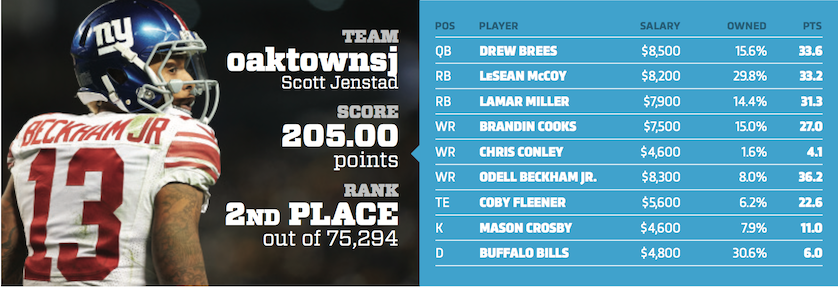
The Shock of a Lifetime
Shortly thereafter, I opened the FanDuel app … and could not believe my eyes. I even went so far as to double check that all the scoring was complete, like an insane person, and also confirm, for the 15th time, that the Monday night game was not included in the FanDuel contest. I couldn't believe it. I knew after the morning games it was going to be a really good day, but I figured Conley and perhaps the Bills D would keep me out of the crazy money.
But when all was said and done, I finished second out of 75,294 teams in the $25 contest and seventh out of 235,294 teams in the $5 contest.
And how important was that Miller touchdown? The six points it provided vaulted me from fifth place in the $25 contest, a small standings jump that resulted in a substantial money jump and turned a great Sunday into an exceptional Sunday.
I texted some screenshots to a few shocked friends, posted in the Google Hangout I share with great friends with whom I talk sports all year, and then flipped the phone to my unsuspecting wife and asked how her birthday weekend ended up. I had not let her in on how well my teams were doing.
The shock on her face was probably the most fun moment of the day.
This article appears in the 2017 RotoWire Fantasy Football magazine. Order the magazine now.


